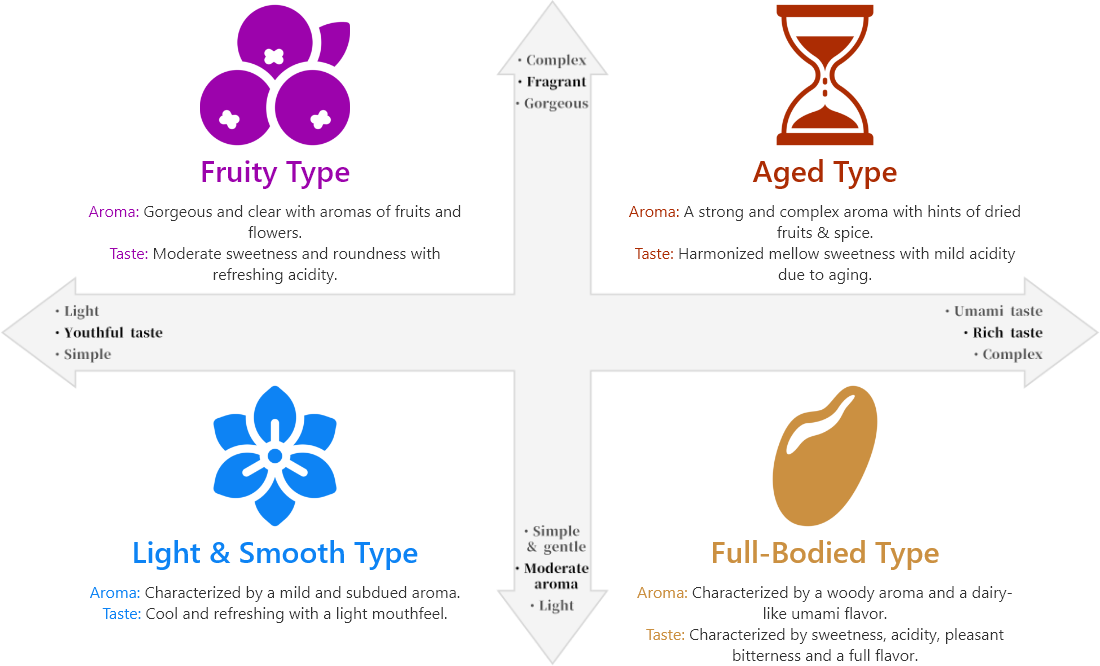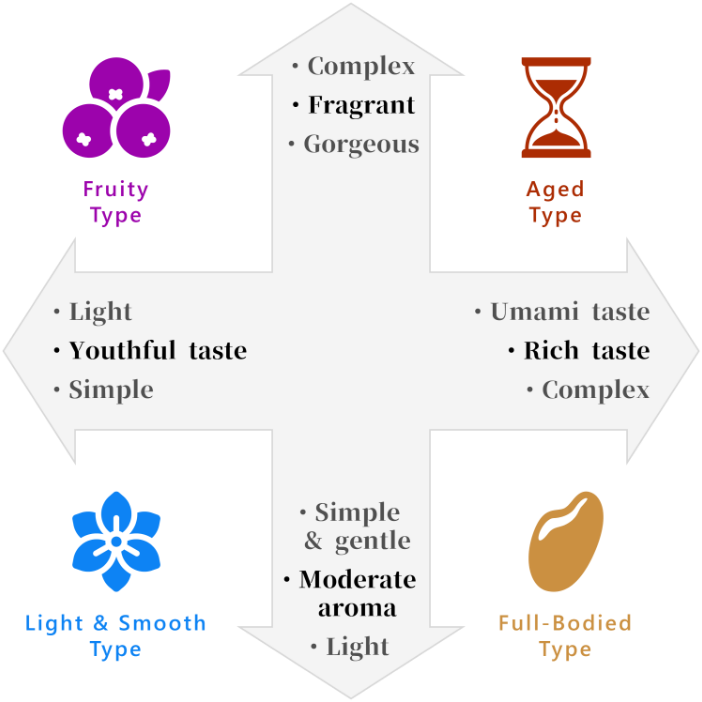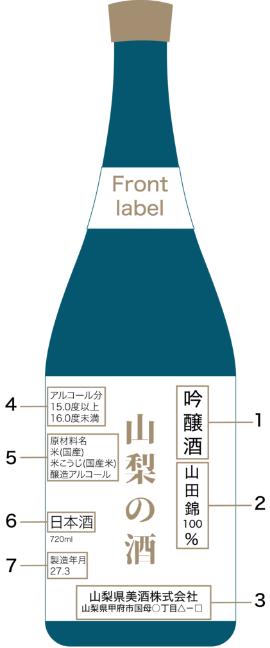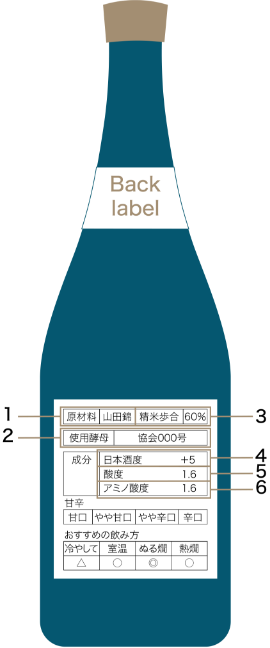
Sake Trivia
The origins of sake
Sake is Japan’s national drink. In ancient times, there are descriptions of rice wine in the Kojiki and Nihonshoki (Chronicles of Japan), and it is thought to have spread throughout Japan with the introduction of rice farming.


Enjoy drinking sake
at different temperatures
Sake is an alcoholic beverage that can be served hot or cold. Learn the names and discover how each temperature influences the taste and aroma of sake.


TOBIKIRIKAN (above 55°C) While it is still possible to hold the tokkuri* and the choko* without getting burnt, at this temperature the sake is stronger and the experience really starts with feeling the heat an enjoying the scent.
ATSUKAN (almost 50°C) As the steam rises from the tokkuri* the aroma of the sake becomes sharper and the taste is drier.
JYOUKAN (almost 45°C) The warmth of the cup is enjoyable particularly during cold winters. At this temperature the aroma of the sake is tightened and the taste is softer.
NURUKAN (almost 40°C) We are close to our body temperature here and the aroma of the sake at this temperature becomes richer and the taste fuller.
HITOHADAKAN (almost 35°C) At this temperature the feel is lukewarm, the aroma of rice and koji can be enjoyed and overall the taste is light and refreshing.
HINATAKAN (almost 30°C) Neither hot nor cold, at 30°C the aroma of the sake is enhanced and the taste is very smooth.
SHITSUON (almost 20°C) This is the temperature of the earthen floor of a Japanese house at this temperature the aroma and taste are softer.
SUZUHIE (almost 15°C) This is state of the sake bottle after it has been out of the refrigerator for a little moment. At this temperature the sake feels cooler with a gorgeous aroma and a thick taste.
HANAHIE (almost 10°C) At this temperature the aroma gradually reveals itslef as we drink it and the taste is fine and light.
YUKIHIE (almost 5°C) Condensation has formed on the surface of the bottle. The aroma is less pronounced, and the cold mouthfeel of the sake can make it difficult to appreciate the subtleties of the flavor.
Tokkuri*: Sake bottle
Choko*: Sake cup
Next time try to say: “HANAHIE, please” when ordering sake at your favorite Japanese restaurant.
Types of Sake
The raw materials used for sake making are water and rice yet,
the taste and aroma can also vary a lot depending on the production methods.



Aroma:Gorgeous and clear with aromas of fruits and flowers.
Taste:Moderate sweetness and roundness with refreshing acidity.

Aroma:A strong and complex aroma with hints of dried fruits & spice.
Taste:Harmonized mellow sweetness with mild acidity due to aging.

Aroma:Characterized by a mild and subdued aroma.
Taste:Cool and refreshing with a light mouthfeel.

Aroma:Characterized by a woody aroma and a dairy-like umami flavor.
Taste:Characterized by sweetness, acidity, pleasant bitterness and a full flavor.
It’s also fun to make your own “Sake Note” by recording the names and impressions of the sake you drink.

How to Read Sake Label
The label on the front and back of the bottle contains a lot of information about the sake.
It includes a message from the sake brewery and reading it can help you select the right sake for the right occasion!

Front label
- 吟醸酒 (Ginjo-shu) – Specific Class Name (Ginjo, Junmai, Honjozo, etc.) Sake is classified into two categories: “Specific Class Name Sake,” which is classified by rice polishing ratio and ingredients, and “ordinary sake,” which is sake outside of specific class name sake. The classification of sake with a specific class name is based on the manufacturing method and ingredients, and does not rank the taste or value of the sake.
- 山田錦 (Yamada-Nishiki) 100% – Variety of raw material rice The variety of rice used in sake brewing may be indicated. Major varieties include Yamada Nishiki, Gohyakumangoku, and Miyamanishiki. There are more than 100 varieties of sake rice.
- 山梨県美酒株式会社 山梨県甲府市国母○丁目△-□ – Name of manufacturer and location of manufacturing facility
- アルコール分15.0度以上16.0度未満 (Alcohol content: 15.0 to 16.0%) – Alcohol content The amount alcohol contained in 100 ml of sake expressed in degrees.
- 原材料名 米(国産) 米こうじ(国産米) 醸造アルコール – Brewing alcohol Generally used to enhance aroma. It is made from sugar cane and cereals. For sake with a specific class name, the alcohol content is limited to 10% or less of the weight of the raw white rice.
- 日本酒720ml – Item Described as “日本酒 (sake)” or “清酒 (rice wine)”.
- 製造年月27.3 – Date of manufacture The year and month when the sake was packed in shipping container at the production site. Sake does not have a best-before date, as its quality will remain unchanged for several years if it is stored in a cool, dark place.

Back label
- 原材料 山田錦―Variety of raw rice
- 使用酵母 協会000号―Use of yeast In general, yeast strains which are cultivated and distributed by the Japan Brewers Association are used, but pure yeast mash from excellent sake brewed in various regions may also be used.
- 精米歩合60% – Polishing ratio Polishing ratio greatly affects the taste and aroma of sake. The rice polishing ratio is only indicated on specific class name sake.
- 日本酒度+5 – Sake meter value Nihonshu-do is a unique measure to indicate the specific gravity of the sake. The standard being 0. Lower scores (-) sake are sweeter than the higher score ones. This is a good indicator to know whether the sake is dry or sweet.
- 酸度1.6―Acidity An indicator of the level of acidity. Sake with high acidity tends to taste rich and dry, while sake with low acidity provide light and sweet tastes. Acids found in sake include lactic acid, malic acid, and succinic acid.
- アミノ酸度1.6―Amino acidity An indicator of the amount of amino acids. Sake with high levels of amino acids has more umami, and those with less amino acids have lighter tastes.
We hope that this will help you select the right sake for the right occasion.


